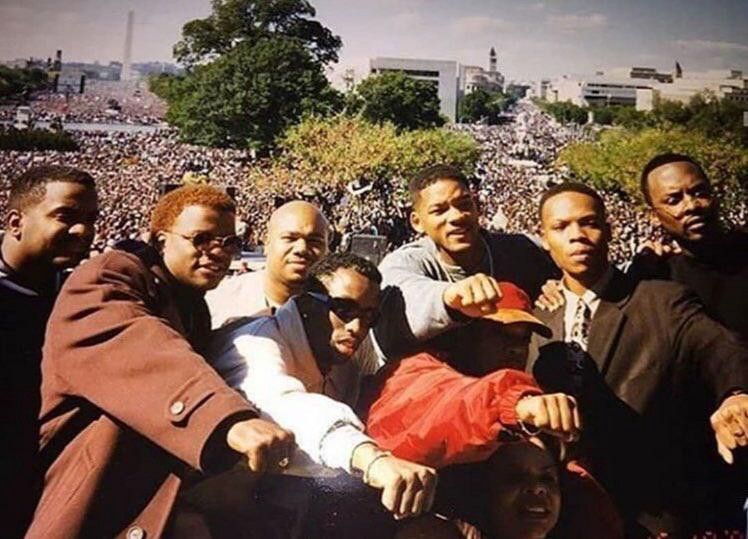There was never a clear consensus on how many men arrived in Washington, D.C. on the morning of October 16, 1995. Was it a million? Twenty-five years later, it doesn’t matter. What history has preserved about the Million Man March is the sheer force of the event — its energy and mission. Black men from all over the country were called to action by a religious leader most didn’t follow. It was bigger than numbers and ideology.
When Nation of Islam firebrand Louis Farrakhan put out the call for Black men to atone and heal their communities, he was such a divisive figure that simply appearing on The Arsenio Hall Show helped bring the highly-rated series to an abrupt end. (Whether the show’s demise was officially tied to Farrakhan’s appearance is unclear. There were definitely other issues. But it didn’t help.)
Looking back, Farrakhan’s charge shouldn’t have worked. Big and Pac were at their height; there was little reason to think the promise of speakers like MC Hammer, Rosa Parks, and Jesse Jackson would compel Black men to show up en masse. But show up they did — with their brothers both biological and Greek, their friends from the barbershop, their co-workers, and their sons.
Some celebrities were in the crowd as well. Archival news photos don’t show many of them, especially the ones who rang bells in hip-hop or young Hollywood, but they were there. Just ask Jeff Dyson. In the above photo, the longtime music and TV insider is flanked by some of the biggest superstars of the moment.
“Throwing up the Black Power fist at an event sponsored by Farrakhan? That wasn’t necessarily on-brand for anyone in this photo. But that was the beauty of the Million Man March.”
How does one get Will Smith (with Jazzy Jeff and Alfonso Ribeiro, no less), in a photo with Diddy and all three members of Bell Biv DeVoe? Below, Dyson brings the day to life, from the backstory to the iconic result. “It just wasn’t iconic then,” he says. “They were men with a purpose — not celebrities with a purpose. Not that day.”
As told to Aliya S. King.
I flew out with Johnny Gill from Los Angeles that morning. I was his road manager and part of his brain trust. Johnny was tight with Farrakhan, so I knew he’d be going, but I went for myself as well. I would have been there no matter what.
The march was historic. You just felt it. Even on the flight from L.A. with Johnny, I saw certain faces, not even necessarily Black men I knew personally. But you could just tell — it was a pilgrimage.
Now, in the picture, it looks like we’re in the crowd but they actually had a section for certain people who couldn’t just be in the crowd. Will and Puff, especially, at that time, could not have just walked in the path with everyone — it would have been a major distraction. So there was an area for certain people. But there were no airs. There was no I’m famous at the event. At all. We were all on a mission.
I don’t know how Johnny’s not in this picture because he was definitely with us — he may have been speaking with Farrakhan.
If I remember correctly, it was Puff who looked around at this moment and said, Hey. We have to get this picture. He organized it. That’s Jamie Foster Brown at the bottom, who was running Sister 2 Sister magazine. Jamie was everywhere so it’s probably her camera we used. She always took pics.
My connection to all of the men in the photo is really special to me because I knew them all in different ways. I worked with New Edition in the early days and when they broke off into their own things, I was working with Johnny Gill.
I’d co-managed Usher in the early days of his career, so I knew Diddy from that relationship — Diddy executive-produced Usher’s first album. I knew Alfonso Ribeiro since he was a little kid, and Will from his early days as well. The only person I didn’t really know was Jazzy Jeff.
That day was a call to arms and a call to action. We all talked about it. I remember when we posed for the picture, we told the person taking the picture to get as much of the crowd behind us as possible. It was beautiful. People as far back as the eye could see.
Why were we there? What did we want? The same things we want now. In 2020, we have a common thread of DNA with the 1995 march and the 1963 March on Washington. Fifty years of police brutality, inequities in our political system, and the overall equality of Black people in the U.S.
Things are so different now, I don’t know if a photo like this would exist in 2020. This is not an awards show or a concert. Will is just coming off of Bad Boys and making that transition from Fresh Prince to movie star; he was very careful about his image. Throwing up the Black Power fist at an event sponsored by Farrakhan? That wasn’t necessarily on-brand for anyone in this photo. But that was the beauty of the Million Man March — it wasn’t about anyone’s individual brand.
This was about the collective whole of Black men. This was one day where we were all equals.
For these Black men to come together in this way for this cause, it still sits with me to this day. People of this stature combined for something that had nothing to do with entertainment. And all the people in this picture? They’re still as down for the cause today as they were that day in 1995.
I’d love to see another moment like this. Twenty-five years later, I think everyone in this picture could be the ones to pull it off.
